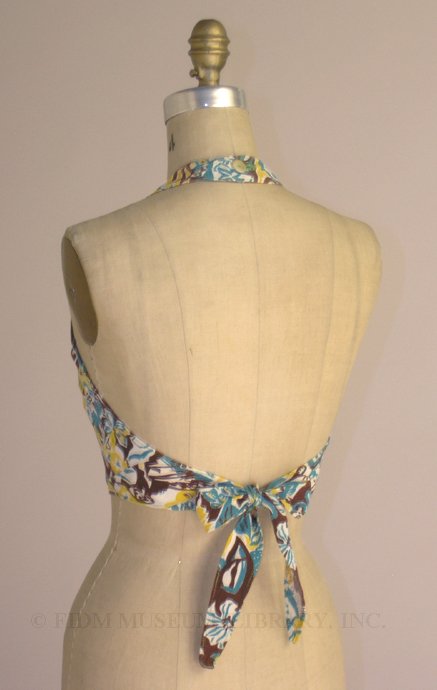What do you have planned for this last long weekend of summer? Depending on where you're located, you could be experiencing a blast of tropical heat, or the first cooling temperatures of fall. Here in Los Angeles, highs of 80-90 degrees are predicted. Perfect weather for a halter top, don't you think?
Halter top
c. 1942-45
Cotton pique
Gift of Anonymous Donor
2003.40.80
Cut to bare the midriff and upper back, this tropical print cotton halter top was an early step towards the body-baring fashions so common today. Bared backs and exposed midriffs were first noted by the fashion press during the 1930s and appeared in evening wear, sportswear, and swimwear. This new style required innovative, purpose-built undergarments. In 1938, Vogue advised its readers to invest in undergarments designed for "the geography of…different dresses," including halter-neck playsuits and backless dresses.1 Despite increasing popularity, these revealing cuts were usually relegated to specific situations: athletic pursuits, vacation lounging, and evenings out on the town. Fashionable daywear of the 1930s and 1940s continued to flatter, but not reveal, the body.
With no label, this playful separate might have been homemade—a self-sufficient strategy encouraged during and immediately after World War II. In the spirit of “make do and mend,” it could have been crafted from another garment or a length of yardage. Period imagery indicates that casual halter tops were often part of an ensemble featuring a coordinating short skirt and summery sandals.
The fabric used in the construction of this top is a wild, swirling mix of brown, yellow, and teal. In the printed pattern, sarong-clad women recline among abstracted tropical flowers and foliage. This imagery evokes thoughts of faraway vacations, something North Americans experienced in large numbers after World War II. Post-war prosperity allowed for more travel, often to tropical locales. Mexico, Puerto Rico, California, Florida, and Cuba were popular vacation destinations, as was Hawaii. The many islands of the Bahamas were also favored, described by Vogue as a land of “sunny days and fragrant, starry evenings.”2 Any of these destinations would have been the perfect setting for this tropically-inspired halter top.
1 "More Than Meets the Eye in Brassieres Designed for Dresses." Vogue (Apr. 1, 1938) 148.
2 "The World of Fashion: Nassau Bound." Vogue (Jan 1, 1941) 41.


